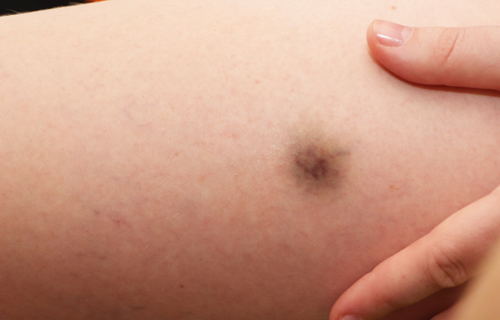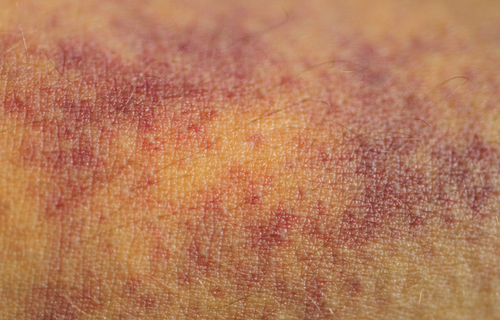Difference Between Ecchymosis and Hematoma
Ecchymosis is a 1 cm or bigger region in which there is some blood that has left the blood vessels producing a purple-colored area on the skin. A hematoma is the blood that has leaked out of vessels, collected, and clotted in an area it shouldn’t be.

What is Ecchymosis?
Definition:
This is defined as an area that looks like a bruise but is where blood is collecting; it is bigger than 1 cm in dimension.
Causes and risk factors:
An ecchymosis can occur from any injury where you knock yourself against some object. It also is more likely in people who are on anticoagulant drugs or have certain medical conditions.
Diagnosis and symptoms:
A physical exam can show the presence of a large purple area that is also flat. This is an ecchymosis.
Treatment:
Painkillers can help if an ecchymosis is painful but usually, it heals soon without a problem.

What is Hematoma?
Definition:
The definition of a hematoma is a region where blood cells and plasma have leaked out of vessels, accumulated, and clotted.
Causes and risk factors:
Trauma such as a fractured bone or head trauma can result in a hematoma. Occasionally during a blood test, the vein may be pierced all the way through causing blood to leak out. Clotting disorders or blood cancer can result in hematomas forming.
Diagnosis and symptoms:
A bruise that is also swollen and painful is an indication you have a hematoma. A doctor can quickly diagnose by visual inspection. However, a brain hematoma needs to be diagnosed using imaging techniques and can be suspected when the person shows neurological signs such as mental confusion and dizziness.
Treatment:
You can use ice to treat the pain of a hematoma. They normally go away on their own. Surgery usually needs to be done to evacuate a subdural hematoma in the brain.
Difference between Ecchymosis and Hematoma?
Definition
Ecchymosis is a larger area of injured and broken blood capillaries and blood. A buildup of blood that has left blood vessels and since coagulated produces a region called a hematoma.
Causes
A type of traumatic injury or the use of anticoagulants can result in the creation of an ecchymosis. Fractured bones or a brain injury may produce a hematoma.
Diagnosis
A visual inspection and the look and size of an area can lead a doctor to diagnose an ecchymosis. Imaging methods and physical appearance lead to diagnoses of hematomas.
Symptoms
Ecchymosis is a purple painful bruise that is bigger than 1 cm. A hematoma is a swollen and bruised region; a hematoma in the brain produces neurological signs like confusion, nausea, and a loss of balance.
Treatment
Painkillers and an ice pack can treat ecchymosis. Brain surgery or ice packs treat hematomas; the exact method depends on where the hematoma is located.
Table comparing Ecchymosis and Hematoma

Summary ofEcchymosis Vs. Hematoma
- An ecchymosis looks much like a bruise but it is a region where blood is leaking out of blood vessels and it is bigger than 1 cm.
- A hematoma is a patch of clotted blood that often occurs under the skin but can happen in the brain, where it is dangerous.
- A hematoma in the brain usually requires surgery to prevent brain damage.
FAQ
Is ecchymosis and bruising the same?
Ecchymosis is a bruise of a larger size of 1 cm or more, where blood is leaking out of the vessels. A bruise is a much smaller area of broken vessels.
How do you tell if a bruise is a hematoma?
A hematoma is often painful and swollen while a bruise is not. You are also more likely to have a hematoma if you break a bone or have quite a severe injury, while a bruise is more likely if you simply bump your arm or leg.
What is an example of ecchymosis?
Ecchymosis is any flat purple-colored region on the skin like you would develop after bumping your leg, or it could result from using certain anticoagulant medicine, causing blood to move out of the vessels.
Is ecchymosis a type of hematoma?
An ecchymosis is not a hematoma because the blood has not clotted.
What is the difference between purpura and ecchymosis?
Purpura are small areas, often spots that occur in the mucus membranes or on the skin. Ecchymosis is a large bruised looking region that is at least 1 cm or more in size; it is also purple in color.
What is spontaneous ecchymosis?
This is when bruising happens easily, typically on the feet and hands, and it is often a sign of a clotting disorder or other illness, causing blood to move out of vessels into the tissue spaces.
What does a hematoma look like?
A hematoma looks like a bruise but is also often swollen and sore.
What is the layman’s commonly used term for ecchymosis?
A layman would call an ecchymosis a large bruise.
- Difference Between Rumination and Regurgitation - June 13, 2024
- Difference Between Pyelectasis and Hydronephrosis - June 4, 2024
- Difference Between Cellulitis and Erysipelas - June 1, 2024
Search DifferenceBetween.net :
References :
[0]Ducruet, Andrew F., et al. "The surgical management of chronic subdural hematoma." Neurosurgical review 35.2 (2012): 155-169.
[1]Epperla, Narendranath, Joseph J. Mazza, and Steven H. Yale. "A review of clinical signs related to ecchymosis." WMJ 114.2 (2015): 61-5.
[2]Stephenson, Terence, and Yvona Bialas. "Estimation of the age of bruising." Archives of Disease in Childhood 74.1 (1996): 53-55.
